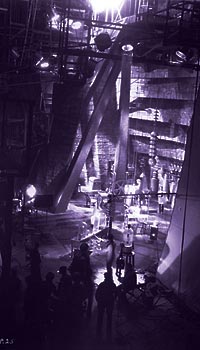Horror films of the '30s and '40s would have been far different if not for the work of one man, Kenneth Strickfaden (born 1896), whose flashing, sparking electrical equipment was a highlight in many films depicting advanced science. Originally his electrical work was only a hobby, but as early as the 1920s Hollywood saw the promise of his machines, and he was kept busy at many studios, providing all manner of amazing effects.
His work was not easy. "Apparatus constantly failed due to overheating," he once revealed to writer Scott MacQueen. "Most effects did not photograph as expected, or they were eliminated due to electrical failures." 1 Despite these unusual, and expected, setbacks, the onscreen results were phenomenal, and far more convincing than any simulations. Strickfaden made much use of the inventions of Nikola Tesla, which had been perfected more than thirty years before the first Universal Studios "Frankenstein" movie. But, unlike Tesla, he was also concerned with the theatrical "look" of his fanciful contraptions, which had to appear to be futuristic and capable of untold wonders. The names he gave the machines were often equally marvelous, such as: "the retrogressive wave charger," "DXL Accumulator," and "High Amperage Pyrogeyser." 2 When, in the late 1940s, real-life scientific marvels turned out to be subtler than Strickfaden's machines, his work apparently went out of fashion and was little seen in Hollywood until the '60s, when it was used extensively in The Munsters TV show and in commercials. Before his death in 1984, 3 he spent much time touring with his "Kenstric Space Age Science Show," educationally demonstrating spectacular electrical phenomena. 4 A few highlights of Strickfaden's career include:
Frankenstein (1931) His equipment brought the monster to life.
The Mask of Fu Manchu (1932) He created a dazzling electrical death ray and doubled for Karloff, who played Fu, when the evil mastermind let powerful lightning dance on his long fingernails.
The Bride of Frankenstein (1935) He staged his ultimate electrical displays for the Bride creation sequence.
The Wizard of Oz (1939) He created the effect of the Wicked Witch of the West trying to remove Dorothy's ruby slippers and receiving an electrical shock.
Fighting Devil Dogs (circa 1941) He manifested projectiles of something like ball lightning.
Sherlock Holmes Faces Death (1943) He simulated an unusually realistic lightning strike.
Young Frankenstein (1974) He recreated some of his best work of long before.
— DC

LEFT: James Whale and his crew film Ernest Thesiger and Dwight Frye amidst Kenneth Strickfaden's electrical equipment in The Bride of Frankenstein.
©1935 Universal Pictures.
NOTES
3. Internet Movie Database, http://us.imdb.com
4. MacQueen, "Strickfaden," p. 26.